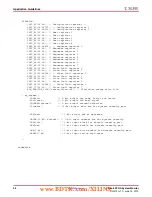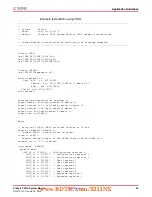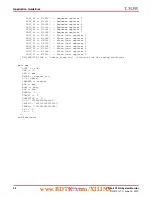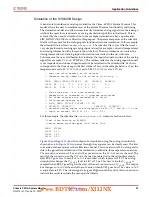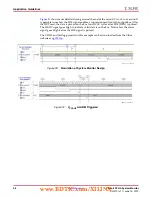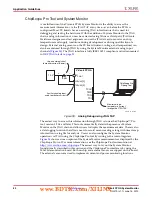
Virtex-6 FPGA System Monitor
45
UG370 (v1.1) June 14, 2010
Application Guidelines
Application Guidelines
The Virtex-6 FPGA System Monitor is a precision analog measurement system based on a
10-bit Analog-to-Digital Converter (ADC) with an LSB size that is approximately equal to
1 mV. To achieve the best possible performance and accuracy with all measurements (both
on-chip and external), a number of dedicated pins for the ADC reference and power
supply are provided. Care must be taken with the connection of these pins to ensure the
best possible performance from the ADC. Basic design guidelines to be considered as part
of the requirements for board design are outlined in this section. Finally, an instantiation of
a basic System Monitor in a design is discussed.
Reference Inputs (V
REFP
and V
REFN
)
These high-impedance inputs are used to deliver a differential-reference voltage for the
analog-to-digital conversion process. ADCs are only as accurate as the reference provided.
Any reference-voltage error results in a gain error vs. the ideal ADC transfer function
(
). Errors in the reference voltage affect the accuracy of absolute
measurements for both on-chip sensors and external channels.
For typical usage, the reference voltage between V
REFP
and V
REFN
should be maintained at
1.25V ± 0.2% using an external reference IC. Reference voltage ICs that deliver 1.25V are
widely available from several vendors. Many vendors offer reference voltage ICs in small
packages (SOT-23 and SC70). The 1.25V reference should be placed as close as possible and
connected directly to the V
REFP
input, using the decoupling capacitors recommended in
the reference IC data sheet. The recommended reference connections are illustrated in
The System Monitor also has an on-chip reference which is selected by connecting V
REFP
and V
REFN
. Due to reduced accuracy, the on-chip
reference does impact the measurement performance of the System Monitor as explained
in this section. The performance with on-chip reference is specified in the
Virtex-6 FPGA
Data Sheet
.
Analog Power Supply and Ground (AV
DD
and AV
SS
)
These inputs provide the power supply and ground reference for the analog circuitry (such
as the ADC) in System Monitor.
A common mechanism for the coupling of noise into an analog circuit is from the power
supply and ground connections. Excessive noise on the analog supply or ground reference
affects the ADC measurement accuracy. For example, I/O switching activity can cause
significant disturbance of the digital ground reference plane.
Thus, it would not be advisable to use the digital ground as an analog ground reference for
System Monitor.
Similarly, for the digital supplies for the FPGA logic, high switching rates easily result in
high-frequency voltage variations on the supply, even with decoupling. In an effort to
mitigate these effects on the ADC performance, a dedicated supply and ground reference
is provided.
illustrates how to use the 2.5V V
CCAUX
supply to power the analog
circuitry. V
CCAUX
is filtered using a low-pass network. The filter design depends on the
ripple and ripple frequency (if any) on the V
CCAUX
supply. There is also a power-supply
region specification for the external reference circuit. The filtering should ensure no more
than 2–3 mV of noise on the reference output to minimize any impact on ADC accuracy.
www.BDTIC.com/XILINX
























